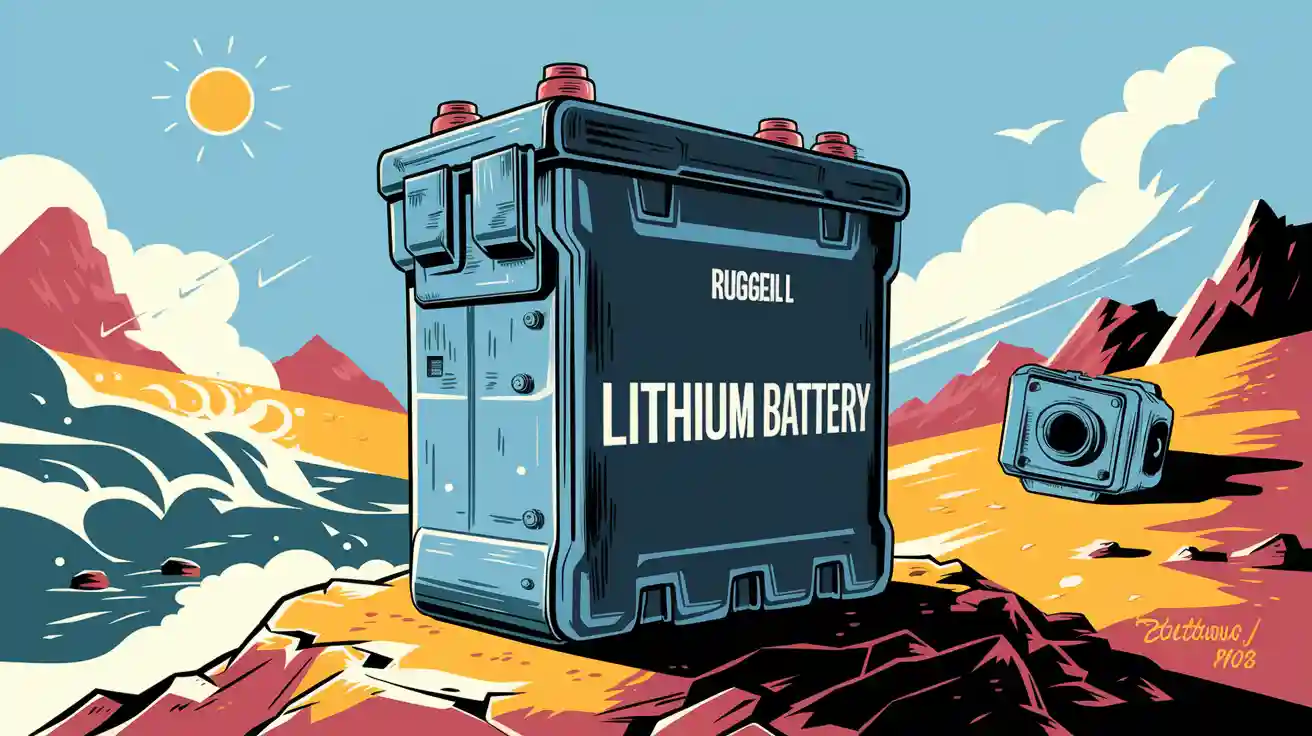
You need batteries that work in the toughest outdoor conditions. High temperatures put stress on lithium battery packs, which can affect safety, performance, and how long they last. The High-Temperature Lithium Battery market keeps growing fast because you demand reliable power for extreme environments.
The table below shows how different battery chemistries handle safety and heat in harsh environments:
Battery Chemistry | Safety Characteristics | Common Applications |
|---|---|---|
Manganese-based | Superior thermal stability, higher resistance to thermal runaway | Medical devices, power tools, electric vehicles |
Cobalt-based | Higher energy densities but more susceptible to thermal runaway | Consumer electronics like smartphones, laptops |
Nickel-based | Balance between safety and performance, less prone to thermal runaway | Hybrid electric vehicles, medical devices |
Iron phosphate-based | Excellent safety characteristics, higher thermal stability, less prone to overheating | Renewable energy storage systems, electric vehicles |
Key Takeaways
High temperatures can significantly reduce the lifespan of lithium batteries. For every 10°C increase above optimal temperatures, battery life can halve.
Choosing the right battery chemistry is crucial. Lithium thionyl chloride (LiSOCl₂) and lithium iron phosphate (LiFePO₄) excel in extreme heat conditions.
Implementing thermal management systems and robust enclosures can enhance battery performance and safety in harsh environments.
Part 1: High Temperatures Challenges

1.1 High Temperatures Impact
High temperatures create serious challenges for lithium battery packs in every environment. You see these effects in medical devices, robotics, security systems, and industrial equipment. When batteries operate above their optimal range, several issues arise:
Rapid growth of the solid-electrolyte interphase (SEI) layer on anodes consumes active lithium and increases internal resistance.
Electrolyte decomposition accelerates, reducing ionic conductivity and causing further capacity loss.
The lifespan of lithium batteries can halve for every 10°C increase above optimal temperatures.
Elevated temperatures speed up the breakdown of battery components, which can lead to thermal runaway and fire risks.
Lithium batteries work best between 20°C and 40°C. Exceeding this range can trigger dangerous conditions, including gas release or explosions.
Battery Operation Temperature | Capacity Fade Rate | Importance of Thermal Management |
|---|---|---|
Elevated | Substantially increased capacity fade | Critical for practical applications |
You must manage heat carefully to maintain battery performance and safety in outdoor or industrial settings.
1.2 Environmental Stress Factors
Outdoor deployments expose lithium battery packs to more than just high temperatures. The environment brings moisture, dust, and fluctuating weather, all of which threaten battery performance and reliability. In sectors like transportation infrastructure and consumer electronics, these factors often cause:
Dust accumulation on terminals and electronics, leading to short circuits and corrosion.
Moisture ingress, which causes corrosion and short circuits, resulting in early battery failure or safety hazards.
Voltage drops at low temperatures, impairing battery performance and reliability.
Overheating risks during extreme heat, which can cause swelling or fire.
The ingress of dust and particulates increases internal resistance and reduces overall battery performance. Moisture can penetrate poorly sealed enclosures, causing corrosion on terminals and power circuits. These problems highlight the need for robust protection and regular maintenance in any harsh environment.
Part 2: High-Temperature Lithium Battery Solutions

2.1 Battery Chemistries and Operating Ranges
When you select a high-temperature lithium battery for outdoor or industrial use, you must consider the chemistry and its ability to handle extreme temperatures. Each chemistry offers unique advantages for energy storage batteries, especially when you need reliable performance under temperature extremes.
Battery Chemistry | Operating Temperature Range (°C) | Key Features |
|---|---|---|
LiSOCl₂ (Lithium thionyl chloride) | -80 to +125 | High energy density, long lifespan, stable in extreme temperatures |
LMO (Lithium metal oxide) | -55 to 85 | Good battery efficiency, moderate cycle life |
LiMn (Lithium manganese dioxide) | -30 to 60 | Reliable for moderate temperature fluctuations |
LiFePO4 (LFP) | -20 to 60 | Excellent safety, long cycle life, robust under temperature extremes |
NMC (Nickel Manganese Cobalt) | 0 to 100 | High charging and discharging efficiency, good sustained energy output |
LCO (Lithium Cobalt Oxide) | 0 to 60 | High energy density, less robust in extreme temperatures |
LTO (Lithium Titanate Oxide) | -30 to 55 | Fast charging, high cycle life, stable under temperature fluctuations |

You can see that LiSOCl₂ and LiFePO4 (lifepo4) batteries stand out for their ability to operate in extreme temperatures. These chemistries support applications where storage and battery efficiency matter most. For example, lifepo4 batteries maintain performance under temperature extremes and offer long-term storage stability.
2.2 Design Features for Durability
You need batteries that last in harsh environments. Manufacturers use several design features to improve the durability of high-temperature lithium battery packs:
Active and passive cooling systems help with temperature regulation and prevent overheating.
Reinforced casings and advanced sealing techniques protect against moisture, dust, and contaminants.
Vibration and shock resistance features ensure reliable operation in mobile or high-vibration settings.
State-of-charge management and thermal stress management reduce degradation and extend battery life.
Benefit | Description |
|---|---|
Environmental Protection | Shields batteries from moisture, dust, and other contaminants that can degrade performance. |
Vibration and Shock Resistance | Damps mechanical vibrations and impacts, essential in high-mobility or high-vibration environments. |
Thermal Management | High thermal conductivity helps dissipate heat, reducing the risk of overheating during operation. |
Improved Safety | Contains hazardous materials or gases during thermal runaway, reducing risk of damage or injury. |
Protection from Contaminants | Acts as a barrier against dust, moisture, and corrosive agents, maintaining consistent performance. |
Tip: Advanced sealing and insulation techniques not only protect your lithium deep cycle battery from environmental hazards but also help maintain battery efficiency and storage capacity over time.
You can learn more about sustainability in battery design here.
2.3 Installation and Maintenance Best Practices
Proper installation and maintenance help you get the most from your high-temperature lithium battery. You should always follow these best practices to ensure reliable storage and performance under temperature extremes:
Choose installation sites with adequate ventilation to prevent overheating.
Avoid direct sunlight or heat sources to reduce battery degradation.
Store devices in a cool, dry place to protect against heat damage.
Conduct regular inspections to identify overheating or damage.
Follow manufacturer’s guidelines for preventive maintenance.
Avoid charging devices when they are hot to the touch.
Use advanced battery management systems to monitor voltage, current, temperature, and state of charge.
Monitor and log temperature data using a data acquisition system for real-time analysis.
Maintenance Protocols | Description |
|---|---|
Advanced Battery Management System (BMS) | Monitors and controls voltage, current, temperature, and state of charge to ensure optimal performance and longevity. (Learn more about BMS) |
Thermal Management | Involves monitoring and regulating operating temperature to protect against extreme heat or cold. |
Charging Protocols | Ensures correct charging voltage and current, preventing overcharging and degradation. |
State of Charge Monitoring | Regularly checks battery charge levels to prevent over-discharge and allows for timely maintenance. |
Electrolyte Maintenance | Involves monitoring levels, preventing contamination, and addressing leakage to enhance battery life. |
Cell Balancing | Ensures all cells maintain similar voltage levels to prevent overcharging or over-discharging. |
Note: Warranty terms often exclude damage caused by storage or operation above recommended temperature ranges. Always check the warranty details for your lithium deep cycle battery.
2.4 Technology Comparison
You want to choose the right high-temperature lithium battery for your application. The table below compares the most common chemistries used in energy storage batteries for outdoor and industrial use:
Chemistry | Operating Temp (°C) | Advantages | Disadvantages | Typical Applications |
|---|---|---|---|---|
LiSOCl₂ (Lithium thionyl chloride) | -80 to +125 | High energy density, long lifespan, stable in extreme temperatures | Limited high current pulse delivery | Remote sensors, metering, backup |
LiFePO4 (LFP, lifepo4) | -20 to 60 | High-temperature stability, long life, excellent safety | Lower energy density than NMC or LCO | Solar storage, EVs, grid storage |
NMC (Nickel Manganese Cobalt) | 0 to 100 | High charging and discharging efficiency, good sustained energy output | Sensitive to temperature fluctuations | EVs, power tools, grid storage |
LCO (Lithium Cobalt Oxide) | 0 to 60 | High energy density, common in consumer electronics | Less robust in extreme temperatures | Phones, laptops, portable devices |
LMO (Lithium Manganese Oxide) | -55 to 85 | Good battery efficiency, moderate cycle life | Lower lifespan in high-temperature environments | Medical, industrial, power tools |
LTO (Lithium Titanate Oxide) | -30 to 55 | Fast charging, high cycle life, stable under temperature fluctuations | Lower energy density | Buses, grid storage, specialty uses |
For more on responsible sourcing, see our conflict minerals statement.
When you compare these chemistries, lifepo4 batteries offer the best balance of safety, cycle life, and performance under temperature extremes. LiSOCl₂ batteries excel in the harshest environments, especially where long-term storage and minimal maintenance are required. NMC batteries provide high charging and discharging efficiency, but you must manage temperature fluctuations carefully to avoid performance loss.
You should also consider total cost of ownership. Batteries with longer service life and lower maintenance needs, such as lifepo4 and LiSOCl₂, often reduce replacement and service costs over time. Proper storage and use of battery management systems further extend the lifespan and reliability of your lithium deep cycle battery.
You can rely on high-temperature lithium battery packs in harsh environments by choosing the right chemistry and following best practices. Recent case studies show:
Temperature cycling from -20°C to +70°C ensures durability.
92% capacity retention after 2,000 cycles at +50°C.
No thermal runaway events detected.
To maximize performance and safety, use this table:
Actionable Step | Description |
|---|---|
Implement thermal management systems | Use active cooling and heating solutions for optimal battery temperatures. |
Incorporate safety features | Add protective circuits and temperature sensors to prevent thermal runaway. |
Select appropriate battery chemistry | Choose chemistries designed for extreme conditions. |
Design effective enclosures | Ensure robust housings provide insulation and protection. |
Follow correct installation procedures | Proper mounting and sensor placement help control temperature. |
Take these steps to extend battery life, improve safety, and ensure reliable power for your business in extreme conditions.
FAQ
What is the best lithium battery chemistry for high temperatures?
You should choose lithium thionyl chloride (LiSOCl₂) or lithium iron phosphate (LiFePO₄) for the best performance in extreme heat.
How can you extend the lifespan of lithium battery packs outdoors?
You should install batteries in ventilated areas, avoid direct sunlight, and use a battery management system for real-time monitoring.
Do lithium battery packs need special enclosures for harsh environments?
Yes. You need robust, sealed enclosures to protect against dust, moisture, and temperature swings. This ensures reliable operation and safety.




